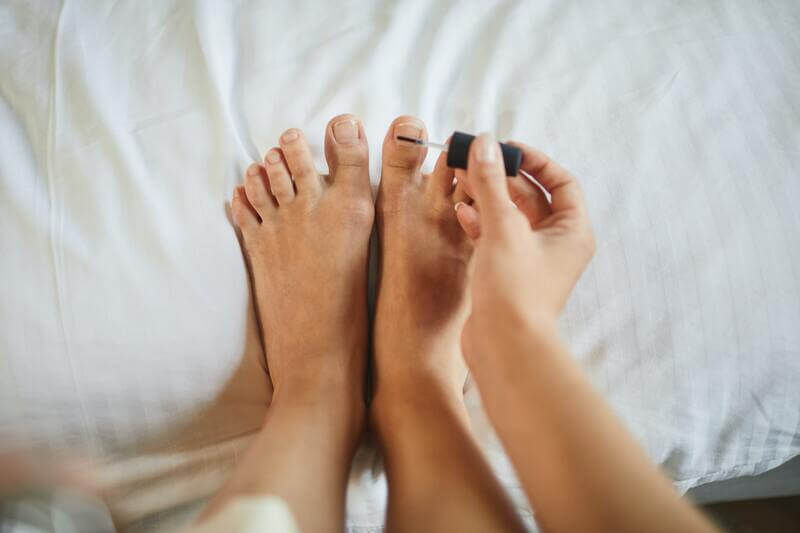
Toenail problems can reveal much about your overall health and provide the first sign of systemic disease. Don’t ignore toenail problems. They are quite common, and treatments are available.
If you have any issues with your toenails, such that you experience signs of infection such as redness, severe pain, drainage, or pus, please contact Advanced Foot and Ankle Wellness Center at (610) 601-6968 to set up a consultation with Dr. Wawrzynek.
Common Toenail Problems
The most common toenail problems include:
- Toenail Fungus
- Ingrown Toenail
- Toenail Trauma
- Clubbed Nails
- Thick Toenails
Toenail Fungus
Toenail fungus or onychomycosis is a common problem that can affect anyone at any age. It is a fungal infection that enters the toenail through cracks in your nail or cuts in your skin. The infection can cause pain and discomfort and change the color and texture of your nail.
Fungal infections thrive in warm and moist environments. Hot, sweaty feet provide a perfect hotbed for fungus to multiply.
Symptoms of Toenail Fungus
If you have toenail fungus, you may see:
- White or yellow discoloration of the nail(s)
- Thickened or oddly shaped nail(s)
- Brittle or crumbly textured nail(s) due to fungal build-up on the nailbed
- Foul-smelling nail(s)
Toenail fungus is infectious, and if left untreated, it can spread to other toenails and the surrounding skin.
Causes of Toenail Fungus
Several things can cause toenail fungus, including:
- Walking barefoot where someone else with an infection has walked (e.g., bathrooms, saunas, and locker rooms)
- Wearing the same sweaty shoes and socks every day
- Athlete’s foot spreading to the toenail bed
- Fungal infection on your foot
- Weakened immune system
- Smoking
- Constricted footwear
- Working in wet conditions
Treatment for Toenail Fungus
Toenail fungus can be challenging to treat, and it may take several months for the fungal nail infection to clear. Treatment options may include
- Prescription creams or ointments
- Swift treatment
- Oral Medications
- Topical Nail Lacquer
- Removal of the toenail to treat the nail bed underneath
Prevention of Toenail Fungus
Prevention is always better than trying to find a cure. Here is a list of things you can do to help prevent toenail fungus.
- Keep your feet clean and dry.
- Avoid walking barefoot in saunas, locker rooms, pools, and public showers.
- Avoid sharing nail clippers.
- Choose a licensed nail salon that uses sterilized instruments.
Patients with diabetes are at a higher risk of developing toenail fungus, so they need to manage their blood sugar levels.
Ingrown Toenail
Sometimes, the edge of a toenail grows into the skin rather than away from it. This is called an ingrown toenail, usually occurring at the nail borders or the sides of the nail. When the edge of the nail cuts into the skin, it is likely to irritate the skin and cause redness, swelling, and pain.
Furthermore, if the nail cuts into the skin, the site can become exposed to bacteria, which can cause an infection. An ingrown toenail often has oozing pus or another drainage, accompanied by a foul odor.
Causes of Ingrown Toenails
Improper trimming is one of the most common causes of ingrown toenails. If the nail is cut too short, the skin next to the nail may fold over the nail and cause an ingrown toenail.
Other causes of ingrown toenails include:
- Heredity
- Trauma to the toe (e.g., stubbed toe or toe crushed by a heavy object)
- Tight or short socks and footwear
- Fungal infections
If you suspect you have an infection, consult with a podiatrist to diagnose and treat your condition.
Treatment for Ingrown Toenails
Dr. Wawrzynek will examine your toe and determine the best treatment for you. If you have an infection, she will prescribe an antibiotic. Make sure to take all the medication as prescribed, even if your symptoms have improved.
Sometimes, removing the affected nail will ease the pain. If the nail becomes ingrown again after initial treatment, Dr. Wawrzynek may have to remove the nail root.
Recovery from minor surgical procedures is usually quick, and most people experience very little pain afterward.
Prevention of Ingrown Toenails
In most cases, ingrown toenails may be prevented by:
- Cutting toenails in a straight line instead of cutting them along the toe curve. Also, don’t cut your toenails too short. You should be able to get your fingernail under the sides and end of the nail.
- Wearing well-fitting shoes that are neither short nor tight in the toe area.
Toenail Trauma
Toenail trauma usually occurs from an injury like stubbing your toes or dropping something heavy on your foot.
Other toenail trauma may result from poorly done pedicures, wearing ill-fitting shoes, or repetitive activities like running or ballet dancing.
Symptoms of Toenail Trauma
Common symptoms of toenail trauma may include
- Pain or Throbbing Sensation
- Bleeding
- A Collection of Blood Under the Toenail
- Toenail Discoloration
- Toenail Thickening
- A Nail Lifting Away from the Skin
- A Complete Separation of the Nail from the Nail Bed
- An injury to the Underlying Bone
Treatment for Toenail Trauma
Treatment for toenail trauma depends on the type of injury but may include medication or surgery.
Clubbed Toenails
Clubbed toenails refer to changes under and around the toenails that cause the toes to take on a widened, club-like appearance.
Symptoms of Clubbed Toenails
If you have clubbed toenails, they may appear wide and round and curve downward.
Other signs may include:
- A pronounced angle between the cuticles and nails
- Soft nail beds
- Floating appearance of the nails
- Bulging of the tips of the toes
Causes of Clubbed Toenails
For some people, clubbed toenails may be an inherited trait, and for others, it may be a sign of a serious underlying medical condition, such as:
- Heart Disease
- Lung Disease
- Cancer
- Gastrointestinal Disorder
Treatment for Clubbed Toenails
The treatment for clubbed toenails requires treating the underlying medical condition.
Thick Toenails
Thick toenails may be caused by problems such as toenail fungus, psoriasis, or diabetes (type 1 or 2). Aging, ill-fitting shoes, and sudden or repeated trauma to the toenails during sports (e.g., running, dancing) can also cause thickened toenails.
Psoriasis is an autoimmune disease that causes red, scaly patches on the skin and can also cause toe- and finger-nails to thicken. If your toenails have thickened due to psoriasis, the nails will likely develop ridges and loosen or separate from the nail bed.
If your nails continue to thicken over time, they may:
- Become brittle and easy to split or crack
- Become foul-smelling
- Appear yellow, green, or brown-hued
- Become difficult to cut or trim
- Look gnarly and have some scaling on the surface
- Become painful
Treatment for Thick Toenails
If you notice thickening and discoloration of your toenails, it may be due to an underlying medical condition. If left untreated, it can cause discomfort and pain.
The treatment for thick toenails usually depends on what is causing the problem. Your doctor will look at your medical history and examine your nails to determine the appropriate treatment.
Dr. Melissa Will Help Get You Back On Your Feet
Dr. Melissa Wawrzynek is a board-certified foot and ankle specialist and offers a broad range of advanced orthopedic, sports medicine, and regenerative treatments.
Our doctor and her team will consult with you regularly to ensure you return to health and receive the highest quality care.
If you’re ready to return to full speed as quickly, easily, and safely as possible, schedule an appointment today.

